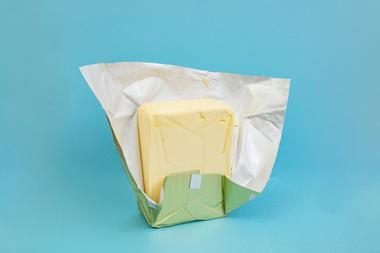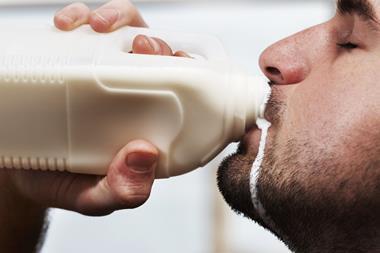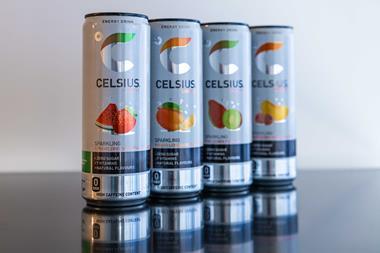Given the lifecycle of the dairy cow, milk producers add a further element of stability and the operation of a dairy farm is a long-term commitment  even though that long-term is moving towards fewer but larger dairy herds.
Yet the past year has been one of the most volatile and turbulent for the dairy industry for well over a decade. This is mainly because world, EU and UK dairy markets have seen wholesale dairy commodity prices falling to levels that few in the industry have ever seen before.
So what factors are creating weak markets?
In milk production there has been a tendency for world milk output to increase, but the expansion in 2001 and the first half of this year has not been exceptional at around 1%.
This has come from a combination of significant growth rates in Australia, New Zealand and the US, balanced by stable output in the EU and some decline in a few countries such as Argentina. The UK has not contributed to any growth as milk output fell short of the annual quota in each of the two years to March 2002, although a seasonal spurt was seen in spring and early summer this year. The normal trend of world dairy consumption has tended to match this modest growth in milk output  but things have not worked out so well over the past year.
In the summer of 2001 the first signs of difficulties emerged when commodity prices on the world market, such as those for butter and milk powders, started showing a downward trend after reaching high levels in the two previous years. This downturn was accentuated by economic developments following the September 11 tragedy, and the trend ever since has been for further price falls.
Recent world skimmed milk powder prices are down by nearly 50% for this period, whole milk powder by a third and butter by at least 25%. And all available evidence suggests these tumbling markets do not reflect any significant decrease in consumption but are mainly due to a lack of confidence in the world economic situation and a reluctance by major wholesale buyers to commit themselves on a forward basis.
The dairy industry in the UK and the EU is partly shielded from these extreme movements in world market prices, but exports have suffered, despite large increases in EU export subsidies for dairy products. Prices for milk powders have fallen in the UK market over the past year by around 20% and Cheddar cheese prices have been down by as much as 25%.
Butter prices have been more stable, mainly because of the price support offered by the EU intervention system which has taken some 13,000 tonnes of surplus product into public stocks in the UK so far this year. Similarly, 22,000 tonnes of UK SMP have been sold into intervention.
The UK industry has also benefited from the lower value of sterling against the euro, which has added about 5% to the level of UK intervention support prices in recent months.
Despite these factors, it has been a difficult year for UK dairy processors as market realisations have come under increasing pressure and stocks of some products have increased, both in intervention stores and in private hands.
The UK cheese market has seen particular difficulties despite the slow overall growth in consumption, most of which has been in the fast food and food processing sectors rather than over the retail counter.
Stocks of Cheddar built up last year and earlier this year and, with poor export outlets, prices for mild cheese crashed in winter and spring from £2,300 per tonne to below £1,700 per tonne. They have now stabilised and are tending to firm as makers pull back excess stocks.
The still-growing mature sector of the Cheddar market has also seen some lower prices this year, but the well-known brands and prized creameries have generally held their position.
Because of pipeline stocks of cheese under maturation, it will probably take the mature sector longer to emerge from an over-stocked position. One effect of low UK Cheddar prices is that imports have dropped away this year by over 20%, leaving UK makers with a larger overall market share of the market.
The same is not true of imported speciality cheeses which continue to gain in popularity with imports looking likely to rise this year by at least 5% following the 10% growth last year.
The UK liquid milk market is, in some ways, the picture of stability with total consumption remaining within 1% of previous year levels. Virtually all this is of domestic origin, there being little scope for shipping such a bulky product over long distances.
Beneath the calm surface, however, competition for business among processors remains as fierce as ever and there is still the view that excess capacity among leading suppliers enables big retailers to extract ever-larger discounts.
These UK market problems, many of which are shared in other parts of the EU, were aggravated this year by exceptionally high production of milk during the flush season of April and May.
The year-on-year expansion of 9% in April, for example, led to existing processing plants being swamped with milk. Various disposal methods had to be used, including the export of tankers of milk, cream and skimmed milk concentrate.
This bountiful situation, however, brought a price to pay during the remainder of the year. Farmers have to conform with an individual milk quota or pay a penalty on excess output. This is assessed on a year to March basis and the high output in the early months of the quota year now has to be matched by lower output during the rest of the year.
Another, more fundamental, problem is that the difficult market has led to a collapse in farm gate milk prices to levels last seen two years ago. In April, for example, average UK milk prices fell by 13% on year-earlier levels, and May's position was even worse with a drop of over 16%.
The position has, if anything, deteriorated in subsequent months. Two years ago concerns began to emerge among dairy processors and even retailers that a milk shortage would result from low milk prices, that fear is being voiced again this year. A lot of dairy farmers are operating at an unprofitable level and, if low prices persist, many of them can be expected to drop out of milk production.
If this trickle became a flood there will certainly be some danger that autumn and winter milk supplies could fall to dangerously low levels.
Another facet of the pressure on UK dairy farmers is the growing view that they need to co-operate more, not only in selling milk but also in the processing chain. Unlike all other dairying countries, UK milk producers have not been co-operative minded and, since the disappearance of the Milk Marketing Boards in 1994, have seen their returns behaving in a volatile fashion.
Whether co-operative-owned processing will reduce that volatility remains to be seen, but a number of new dairies owned by farmers have opened this year and all the major milk selling co-ops are now raising capital from their members for more significant pushes into vertically integrated milk processing.
At the same time, it would seem that leading plc dairy companies are finding it difficult to earn what, for them, are satisfactory levels of profit.
It is proof of changing times that the two former leading UK dairy companies, Unigate and Northern Foods, have now totally quit the dairy sector. Perhaps a quiet structural revolution is under way.
{{Z SUPPLEMENTS }}
Yet the past year has been one of the most volatile and turbulent for the dairy industry for well over a decade. This is mainly because world, EU and UK dairy markets have seen wholesale dairy commodity prices falling to levels that few in the industry have ever seen before.
So what factors are creating weak markets?
In milk production there has been a tendency for world milk output to increase, but the expansion in 2001 and the first half of this year has not been exceptional at around 1%.
This has come from a combination of significant growth rates in Australia, New Zealand and the US, balanced by stable output in the EU and some decline in a few countries such as Argentina. The UK has not contributed to any growth as milk output fell short of the annual quota in each of the two years to March 2002, although a seasonal spurt was seen in spring and early summer this year. The normal trend of world dairy consumption has tended to match this modest growth in milk output  but things have not worked out so well over the past year.
In the summer of 2001 the first signs of difficulties emerged when commodity prices on the world market, such as those for butter and milk powders, started showing a downward trend after reaching high levels in the two previous years. This downturn was accentuated by economic developments following the September 11 tragedy, and the trend ever since has been for further price falls.
Recent world skimmed milk powder prices are down by nearly 50% for this period, whole milk powder by a third and butter by at least 25%. And all available evidence suggests these tumbling markets do not reflect any significant decrease in consumption but are mainly due to a lack of confidence in the world economic situation and a reluctance by major wholesale buyers to commit themselves on a forward basis.
The dairy industry in the UK and the EU is partly shielded from these extreme movements in world market prices, but exports have suffered, despite large increases in EU export subsidies for dairy products. Prices for milk powders have fallen in the UK market over the past year by around 20% and Cheddar cheese prices have been down by as much as 25%.
Butter prices have been more stable, mainly because of the price support offered by the EU intervention system which has taken some 13,000 tonnes of surplus product into public stocks in the UK so far this year. Similarly, 22,000 tonnes of UK SMP have been sold into intervention.
The UK industry has also benefited from the lower value of sterling against the euro, which has added about 5% to the level of UK intervention support prices in recent months.
Despite these factors, it has been a difficult year for UK dairy processors as market realisations have come under increasing pressure and stocks of some products have increased, both in intervention stores and in private hands.
The UK cheese market has seen particular difficulties despite the slow overall growth in consumption, most of which has been in the fast food and food processing sectors rather than over the retail counter.
Stocks of Cheddar built up last year and earlier this year and, with poor export outlets, prices for mild cheese crashed in winter and spring from £2,300 per tonne to below £1,700 per tonne. They have now stabilised and are tending to firm as makers pull back excess stocks.
The still-growing mature sector of the Cheddar market has also seen some lower prices this year, but the well-known brands and prized creameries have generally held their position.
Because of pipeline stocks of cheese under maturation, it will probably take the mature sector longer to emerge from an over-stocked position. One effect of low UK Cheddar prices is that imports have dropped away this year by over 20%, leaving UK makers with a larger overall market share of the market.
The same is not true of imported speciality cheeses which continue to gain in popularity with imports looking likely to rise this year by at least 5% following the 10% growth last year.
The UK liquid milk market is, in some ways, the picture of stability with total consumption remaining within 1% of previous year levels. Virtually all this is of domestic origin, there being little scope for shipping such a bulky product over long distances.
Beneath the calm surface, however, competition for business among processors remains as fierce as ever and there is still the view that excess capacity among leading suppliers enables big retailers to extract ever-larger discounts.
These UK market problems, many of which are shared in other parts of the EU, were aggravated this year by exceptionally high production of milk during the flush season of April and May.
The year-on-year expansion of 9% in April, for example, led to existing processing plants being swamped with milk. Various disposal methods had to be used, including the export of tankers of milk, cream and skimmed milk concentrate.
This bountiful situation, however, brought a price to pay during the remainder of the year. Farmers have to conform with an individual milk quota or pay a penalty on excess output. This is assessed on a year to March basis and the high output in the early months of the quota year now has to be matched by lower output during the rest of the year.
Another, more fundamental, problem is that the difficult market has led to a collapse in farm gate milk prices to levels last seen two years ago. In April, for example, average UK milk prices fell by 13% on year-earlier levels, and May's position was even worse with a drop of over 16%.
The position has, if anything, deteriorated in subsequent months. Two years ago concerns began to emerge among dairy processors and even retailers that a milk shortage would result from low milk prices, that fear is being voiced again this year. A lot of dairy farmers are operating at an unprofitable level and, if low prices persist, many of them can be expected to drop out of milk production.
If this trickle became a flood there will certainly be some danger that autumn and winter milk supplies could fall to dangerously low levels.
Another facet of the pressure on UK dairy farmers is the growing view that they need to co-operate more, not only in selling milk but also in the processing chain. Unlike all other dairying countries, UK milk producers have not been co-operative minded and, since the disappearance of the Milk Marketing Boards in 1994, have seen their returns behaving in a volatile fashion.
Whether co-operative-owned processing will reduce that volatility remains to be seen, but a number of new dairies owned by farmers have opened this year and all the major milk selling co-ops are now raising capital from their members for more significant pushes into vertically integrated milk processing.
At the same time, it would seem that leading plc dairy companies are finding it difficult to earn what, for them, are satisfactory levels of profit.
It is proof of changing times that the two former leading UK dairy companies, Unigate and Northern Foods, have now totally quit the dairy sector. Perhaps a quiet structural revolution is under way.
{{Z SUPPLEMENTS }}



















No comments yet